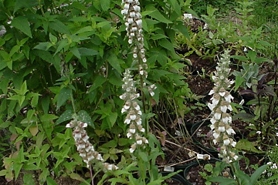Grecian Foxglove
(Digitalis lanata)
Invasive ornamental with tall flower stalks, plants reaching 2-5' tall. Plants have woolly stems, and tubular-shaped flowers are creamy white on the outside with purple-brownish venations on the inside. All parts of this plant are highly toxic; avoid direct contact with skin and do not burn plant debris.
Other names for this plant include:
- Common names: woolly foxglove, woolly digitalis.
Classification in Wisconsin: Prohibited
- Ecological Threat
-
- Invades grasslands, savannas, prairies, forest edges, river bluffs and disturbed areas such as roadsides and fields.
- Based on this species' native range, it is tolerant of colonizing various conditions from sunny and dry to cool and moist.
- Plants are toxic to humans, livestock and wildlife due to chemicals known as cardiac glycosides.
- Multiple species of the Digitalis genus can hybridize; however, hybrids have not yet been reported.
- This species is listed as an invasive species in both Minnesota and Kansas.
- Identification
-
Leaves & stems: Plants are biennial or perennial. First-year leaves form a basal rosette. Leaves are simple with alternate arrangements, oblong coming to a pointed tip.
Flowers: The exterior of the tubular-shaped flowers is creamy white to yellowish. The lip of the flower is often more white than the rest of the flower. Markings on the inside of the flowers are purple-brownish venations. Stems and calyx are wooly, covered in dense thick hairs.
Fruits & seeds: Seed pods have distinct hooks at the tip. This plant spreads by seeds.
Similar species: Common or garden foxglove (Digitalis purpura; non-native) is very similar but can be distinguished by flower color (common being purple but in a wide assortment), and it lacks woolly hairs on the stems. It also resembles D.grandiflora, non-native yellow foxglove.
- Control
- Mechanical:
- This plant spreads by seed; cut plants during the flowering stage, before seed-set.
- Monitor population as plants can re-flower when cut and take on a prostrate growth form.
- Herbicide trials conducted in Minnesota determined that Metsulfron methyl (Escort®) was the most successful in 3 gallons of water with 94% kill.
- Picloram (Tordon K®), with 0.5 gallons of water plus a surfactant, is also effective when sprayed in the fall at 86% kill.
- For more information on treatments, visit the Herbicide Trials on Grecian foxglove [exit DNR].
- Resources
- Sources for content:
- Minnesota Department of Agriculture
- Minnesota Department of Transportation; Herbicide Trials on Grecian Foxglove (Digitalis lanata) Along State Highway 95 Right-of-Way in Minnesota
- United States Department of Agriculture, Germplasm Resources Information Network (GRIN)



